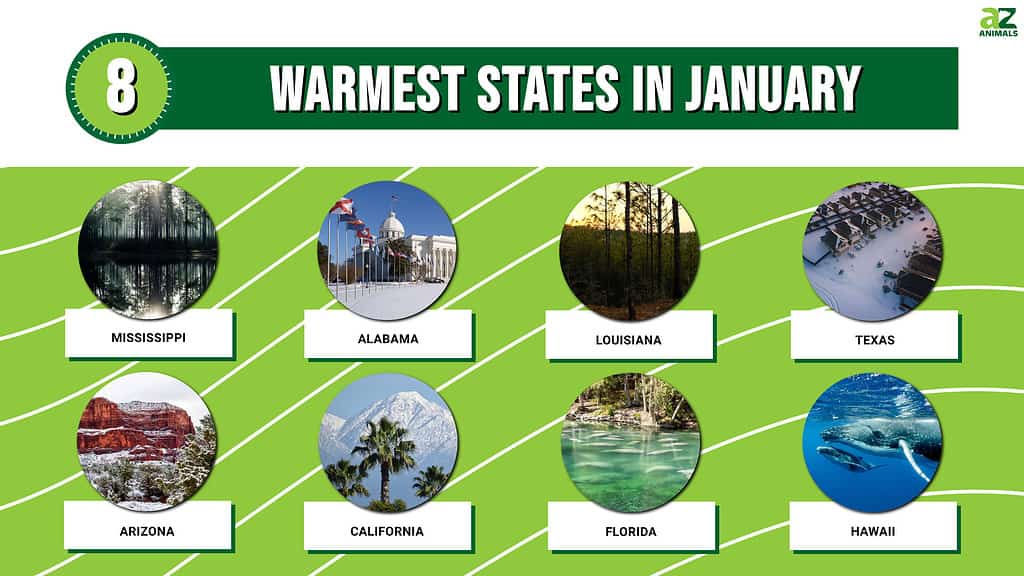
January is the middle of winter so most areas of the United States are either blanketed in snow, receiving tons of rain, or are just really cold. However, there are a few states where the weather doesn’t get too bad during January. Most states during winter average about 30-40°F and that’s on the high end. The average low temperatures can get to as cold as 10°F which can easily cause hypothermia if someone is exposed long enough.
On the other end, some states have average lows of close to 60°F which is pretty nice for winter weather. In this article, we will show you the warmest states in January and their average temperatures. Now let’s discover the 8 warmest states in January.
8. Mississippi
| Mississippi | ||
|---|---|---|
| Population | Avg. January Temp. High | Avg. January Temp. Low |
| 2.95 million | 56°F | 34°F |
In the United States Mississippi is one of the warmest states in January, and its winters are mild. Summer in the state is extremely hot, making it one of the hottest regions. The hottest temperature ever recorded in the state was in the summer of 1930 when it reached a scorching 115°F.
While not the largest state, Mississippi has a size of 48,432 square miles. Mississippi gets around 50 to 65 inches of rainfall yearly, and only gets around 1 inch of snow on average. Marshes, forests, and coastal woodlands are the types of habitats you may find within Mississippi, which support the state’s different wildlife.
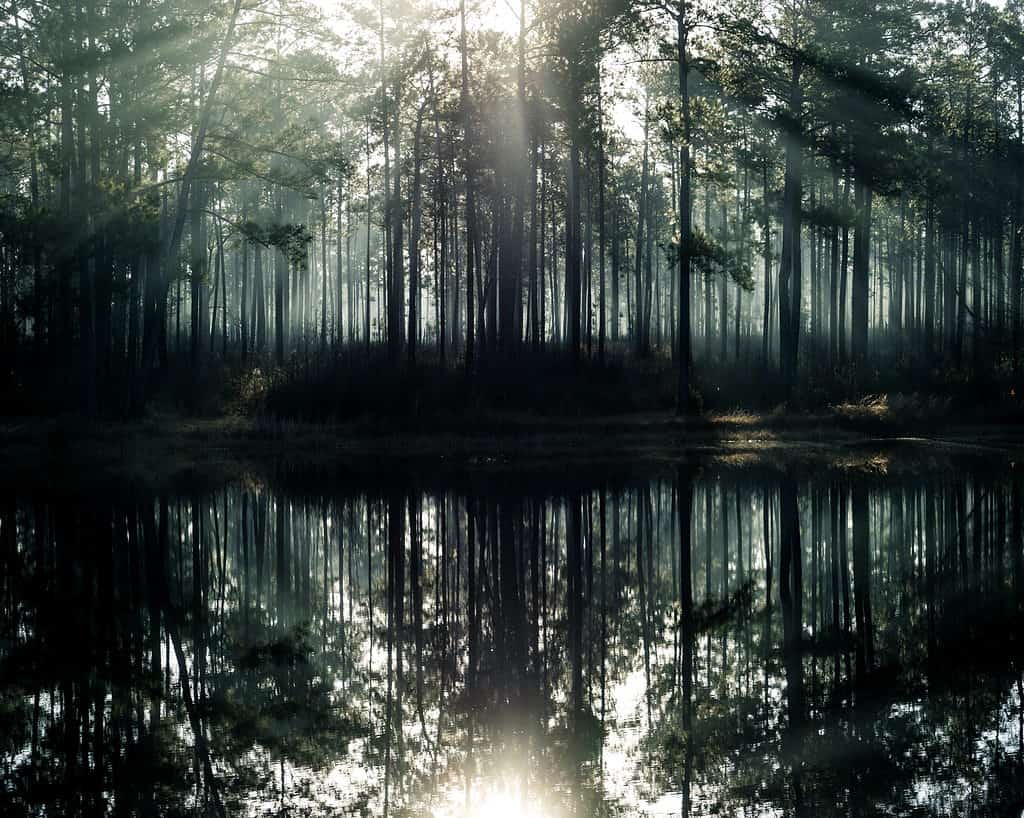
In the United States Mississippi is one of the warmest states in January, and its winters are mild.
©Steven L.J. Reich/Shutterstock.com
7. Alabama
| Alabama | ||
|---|---|---|
| Population | Avg. January Temp. High | Avg. January Temp. Low |
| 5.04 million | 56°F | 34°F |
In January Alabama is considered one of the warmest places, much like other regions in the southeastern United States. Snow is not a common occurrence in the state due to Alabama’s mild winter. Summers in Alabama have reached as high as 112°F, and the coldest temperature ever recorded was -27°F. Despite its lack of snow, Alabama does have an average of 56 inches of rainfall yearly.
Forests, woodlands, prairies, and marshlands are the common habitats in Alabama. You can find around at least 62 native mammals, 93 reptile species, and 73 amphibians, making it one of the most biodiverse states within America. With a size of 52,419 square miles, Alabama is around 3.2% water. 70 percent of the state forests, which help house its diverse wildlife.
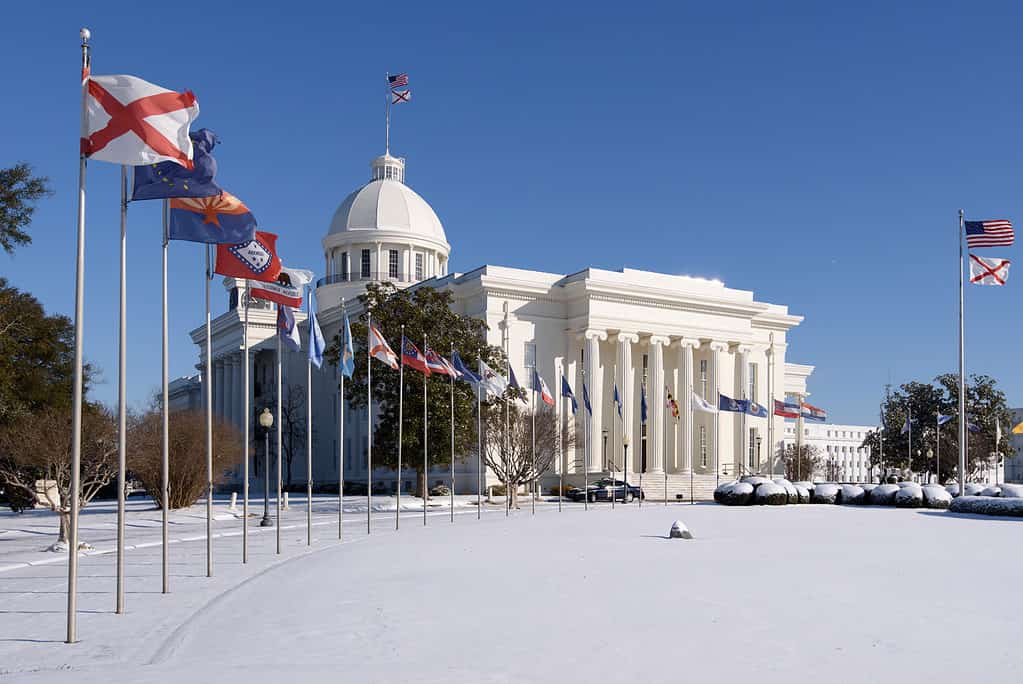
Snow is not a common occurrence in the state due to Alabama’s mild winter and when it does, the area affected shuts down.
©Sutherland Boswell/Shutterstock.com
6. Louisiana
| Louisiana | ||
|---|---|---|
| Population | Avg. January Temp. High | Avg. January Temp. Low |
| 4.624 million | 63°F | 50°F |
On Average Louisiana only receives 0.2 inches of snow yearly. The state is one of the warmest in January, and while winters can reach freezing temperatures, heavy snowfall is not common. The hottest temperature ever recorded in Louisiana was 144°F, and the all-time low was -16°F. Louisiana in winter usually ranges between 48 °F to 60°F. Rain is very abundant, and Louisiana is considered the second wettest state, receiving an average of 60 inches of rainfall per year.
Marshes, woodlands, and prairies are the most common habitats in the state. You can find a variety of life in Louisiana like otters, foxes, ringtails, coyotes, deer, and bears. The state has a subtropical climate and is known for its great food, and culture, influenced by the diverse group of people that inhabited the region.
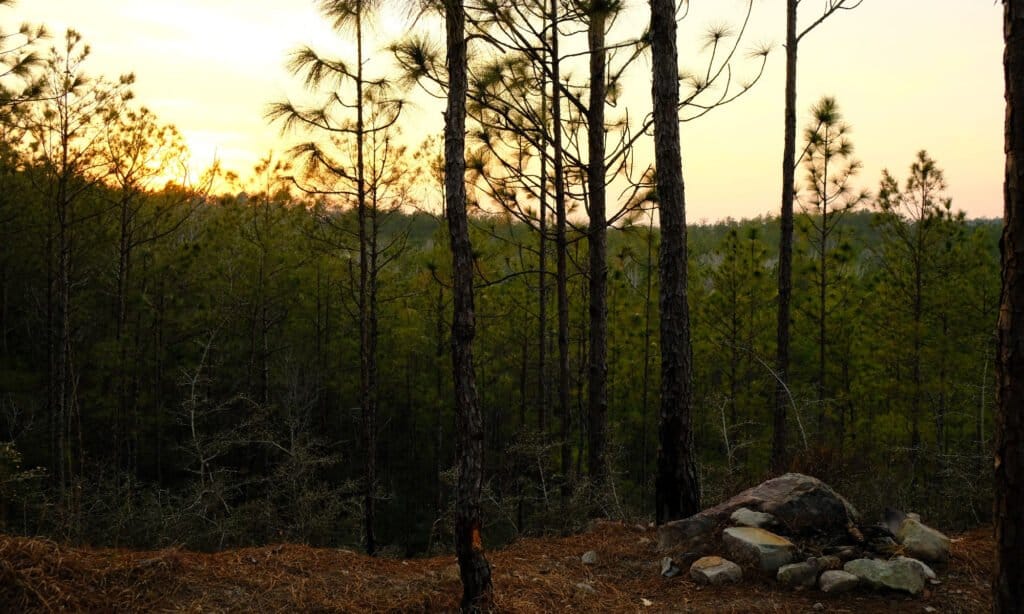
On Average Louisiana only receives 0.2 inches of snow yearly.
©William Dillingham/Shutterstock.com
5. Texas
| Texas | ||
|---|---|---|
| Population | Avg. January Temp. High | Avg. January Temp. Low |
| 29.53 million | 65°F | 45°F |
With a size of 268,567 square miles, Texas is the second largest state in the U.S. Despite January being the state’s coldest month, Texas has a relatively mild temperature that is much warmer than other areas within the United States. McAllen is considered the warmest city in Texas and is right near the border of Mexico. The northern Texas Panhandle and Oklahoma Panhandle get the most snow in the state. On average the state only has around 0.1 inches of snowfall across the state.
Texas is a diverse state that has 10 natural ecoregions. Forests, wetlands, grasslands, coastal prairies, and savannas are just a few of the habitats in the state. Texas is home to a myriad of life like alligators, bats, deer, cougars, rattlesnakes, and armadillos just to name a few. Just like the different types of temperatures across Texas, there lives an ample variety of life.

The extreme Winter Storm Uri covered Austin Texas in Snow.
©iStock.com/RoschetzkyIstockPhoto
4. Arizona
| Arizona | ||
|---|---|---|
| Population | Avg. January Temp. High | Avg. January Temp. Low |
| 7.276 million | 67°F | 45°F |
In the United States Arizona is one of four desert states, with around one-third of the region being arid. In the state, the average January temperatures range from a high of 69 degrees to a low of 45 degrees Fahrenheit. The state’s diverse landscape makes it possible for there to be a large range of temperatures during winter. Yuma is the warmest city in the state during winter, while Haley lake is the coldest region in Arizona. A high of 128°F was the hottest Arizona has ever reached, while the coldest it has ever been was -40°F.
Snow can occur all across Arizona in the winter, but it is more prevalent in the high-elevation mountain regions. The state is filled with wildlife like coyotes, deer, javelina, and black bears. The desert habitat in the state houses animals like the Gila monster, road runner, and chuckwalla.

Sometimes it snows in Arizona!
©Monica Lara/Shutterstock.com
3. California
| California | ||
|---|---|---|
| Population | Avg. January Temp. High | Avg. January Temp. Low |
| 39.24 million | 68°F | 56°F |
California is extremely diverse when it comes to landscape and wildlife. It is one of the few places in the world where you can find snow, beaches, deserts, and forests all within a few hours of each other. Winter weather in California is different in each area with some areas receiving snow while others stay sunny almost all year round. Southern California averages temperatures in the mid to low 70s throughout winter.
With over 482 cities and towns California is the most populated state in the country. Even with over 39 million people living in the state, there’s still plenty of wildlife to see even during the winter. January is a great time to see gray whale migration in southern California. All throughout the state wildlife is abundant. In mountainous regions animals like bighorn sheep, and mountain lions, and in lower elevations in some areas, bears can be seen foraging for food instead of taking their long winter nap.

A snapshot of a snow-covered peak in the San Gabriel Mountains as it towers above five palm trees in Southern California.
©iStock.com/Richard Par
2. Florida
| Florida | ||
|---|---|---|
| Population | Avg. January Temp. High | Avg. January Temp. Low |
| 21.78 million | 76°F | 57°F |
During January Florida is the warmest state in the Continental United States. While winter in Florida does bring crisp and cool temperatures the weather is still sunny and warm enough to be pleasant. This time of year Florida does see higher winds. While yearly Florida has around 54 inches of rainfall, the state remains with no rain for around 69% of the year. During January birdwatchers can hear the calls of male cardinals as well as watch the nesting activities of Roseate spoonbill, ospreys, sandhill cranes, hawks, and owls.

A herd of Florida Manatee swimming in the crystal-clear spring water at Blue Spring State Park in Florida, USA, a winter gathering site for manatees.
©JHVEPhoto/Shutterstock.com
1. Hawaii
| Hawaii | ||
|---|---|---|
| Population | Avg. January Temp. High | Avg. January Temp. Low |
| 1.442 million | 81°F | 65°F |
Hawaii has hundreds of islands but there are six main islands. These islands are Hawai’i, Kaua’i, Lana’i, Maui, Moloka’i, and O’ahu. Each of these islands experiences an average temperature of 75°F and above during January. Hawaii in January is typically warm and sunny though it does follow the rainiest month of the year, December, so rainfall is possible in some areas. Islands like Maui and Oahu see the lowest rainfall and are almost always sunny during winter. Even though it’s winter, January is one of the best months to spot certain wildlife in Hawaii. Animals like humpback whales migrate in pods from December to April so January is a great time to see these majestic creatures.
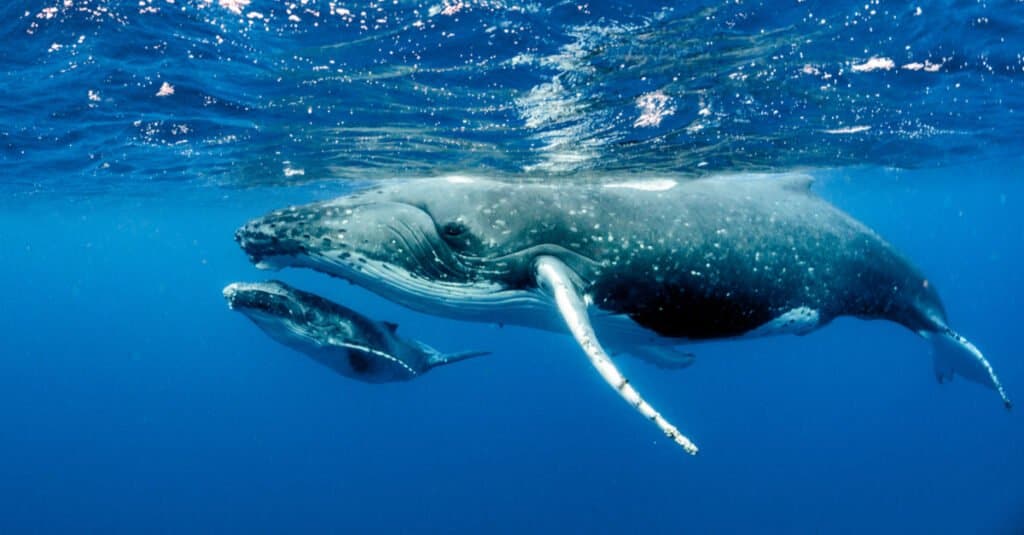
Each winter, as many as 10,000 humpback whales travel from Alaska to Hawaii. This incredible animal migration starts in November and lasts until around May.
©Imagine Earth Photography/Shutterstock.com
Up Next:
- Discover the 5 Most Populated Cities In The United States
- The 15 Deepest Lakes in the United States
- The Top 10 Coldest U.S. States
- Which US States Have the Most Floods, and Why?
The photo featured at the top of this post is © Shane Myers Photography/Shutterstock.com
FAQs (Frequently Asked Questions)
What is Hawaii like in January?
Hawaii in January is typically warm and sunny though it does follow the rainiest month of the year, December, so rainfall is possible in some areas.
What is the warmest state in the Continental US during January?
During January Florida is the warmest state in the Continental United States. While winter in Florida does bring crisp and cool temperatures the weather is still sunny and warm enough to be pleasant.
Thank you for reading! Have some feedback for us? Contact the AZ Animals editorial team.






